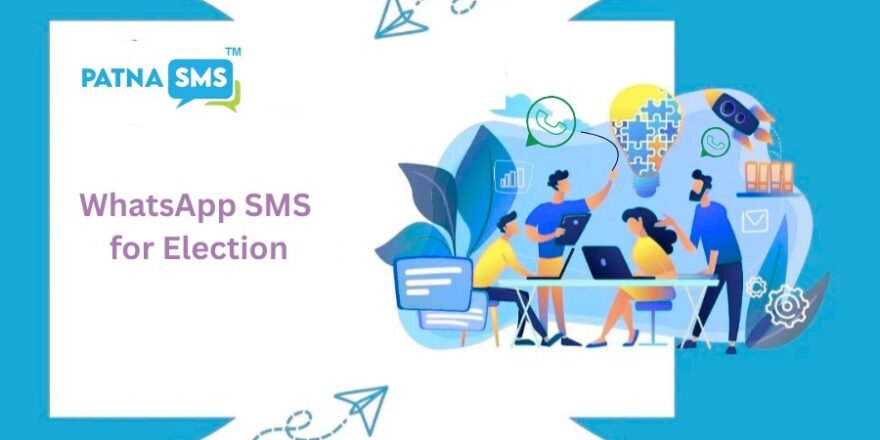Elections are not just about voting—they are about communication, connection, and clarity. In today’s fast-paced digital era, Transactional SMS for Election has emerged as one of the most reliable, secure, and efficient mediums to connect with voters. From updating citizens about their polling stations to reminding them of voter ID requirements, transactional SMS ensures that critical election-related information reaches every individual instantly and without interruption.
Unlike promotional SMS, which is often used for marketing campaigns, transactional SMS is specifically designed for delivering important information. In the context of elections, this means sending out official updates, alerts, and reminders that are timely, accurate, and highly relevant. With the rise of mobile penetration in India and across the globe, transactional SMS has become a lifeline for election commissions, political parties, and voters alike.
This article dives deep into the importance, benefits, strategies, and future potential of Transactional SMS for Election, and how it can transform the way we manage democratic processes.
What is Transactional SMS for Election?
Before we explore its applications, it is essential to understand what transactional SMS actually means.
- Transactional SMS is a type of SMS service used to send crucial, non-promotional information to users.
- Unlike promotional messages, which can only be sent during certain hours, transactional SMS can be delivered 24/7—even on DND (Do Not Disturb) numbers.
- These SMS usually include updates, reminders, OTPs, confirmations, alerts, and official notifications.
When applied to the election system, Transactional SMS for Election becomes a tool of empowerment. It allows election authorities and related organizations to deliver timely messages like:
- Voter registration confirmation.
- Polling booth details.
- Voter ID application status.
- Reminders about polling dates.
- Alerts about last-minute changes in polling stations.
- Emergency updates regarding weather or law & order situations on polling day.
Why Transactional SMS for Election is Important
Elections are large-scale operations that require seamless coordination between millions of citizens, polling staff, and government agencies. Traditional methods like posters, newspapers, and television advertisements still have their place, but they lack personalization and real-time delivery.
Here’s why Transactional SMS for Election is a game-changer:
- Instant Communication – Messages are delivered instantly to voters, ensuring no delay in critical information.
- High Open Rate – SMS has an open rate of over 98%, far higher than emails or social media posts.
- Universal Access – Even in rural or remote areas where internet penetration is low, mobile phones are widely used, making SMS the most accessible communication tool.
- Trustworthy and Secure – Transactional SMS is associated with official updates, so voters trust the information more than random promotional messages.
- Cost-Effective – Compared to physical outreach campaigns, SMS is more economical, especially when dealing with millions of voters.
- 24/7 Availability – Transactional SMS can be sent at any time, even during odd hours, ensuring voters receive updates whenever required.
- Compliance-Friendly – Since it is not a marketing activity, it does not violate DND rules or electoral code of conduct guidelines.
Applications of Transactional SMS for Election
The use of Transactional SMS for Election extends across multiple stakeholders—from voters to officials. Let’s break down its key applications.
1. Voter Registration & Verification
- Confirmation of successful voter registration.
- Updates about errors in application or missing documents.
- Information on voter ID card delivery.
2. Polling Information
- Details of assigned polling station with Google Map link.
- Polling date and time reminders.
- Special instructions for first-time voters.
3. Election Awareness & Participation
- Reminders to carry voter ID cards and necessary documents.
- Awareness about safe voting practices.
- Alerts about the last date for filing nominations for candidates.
4. Staff & Volunteer Communication
- Training session schedules for election staff.
- Real-time alerts for polling booth staff regarding security or technical issues.
- Coordination messages for volunteers and government officials.
5. Security & Emergency Alerts
- Real-time updates about security arrangements.
- Alerts in case of disturbances or law & order problems.
- Weather alerts in regions prone to heavy rain or natural disruptions.
6. Post-Election Communication
- Thank-you messages for voter participation.
- Alerts about vote counting schedules.
- Updates on election results and official announcements.
Benefits of Using Transactional SMS in Elections
For Election Commission
- Efficient voter communication.
- Reduced dependency on traditional media.
- Real-time engagement.
For Political Parties
- Direct and personalized voter reach.
- Cost savings in campaigning.
- Higher voter turnout through reminders.
For Voters
- Access to transparent, authentic information.
- Easy reminders for voting day.
- Reduced chances of misinformation.
How Transactional SMS for Election Works

The process of deploying Transactional SMS for Election is straightforward:
- Integration with Election Database – Voter details (name, mobile number, constituency, booth details) are stored in the database.
- Message Customization – Personalized messages are created, such as “Dear [Name], your polling booth is [Location]. Please vote on [Date].”
- SMS Gateway Connection – Messages are sent using a secure SMS gateway with high delivery rates.
- Real-Time Delivery Reports – Election authorities can monitor who received the messages, ensuring accountability.
Best Practices for Implementing Transactional SMS for Election
To make the most of SMS communication, here are some best practices:
- Personalization – Use the voter’s name and constituency details.
- Clarity – Keep the message short, clear, and actionable.
- Timeliness – Send reminders close to the event (e.g., one day before polling).
- Language Accessibility – Send messages in the voter’s local language for better understanding.
- Two-Way Interaction – Enable voters to reply for queries or assistance.
- Security – Ensure the SMS gateway is secure to prevent misuse or misinformation.
Real-World Examples of Transactional SMS for Election
- India: During Lok Sabha and State Assembly elections, SMS services have been used to remind voters about polling dates and locations.
- United States: Election commissions send SMS reminders about early voting deadlines.
- Africa: Countries like Kenya and Nigeria use SMS to fight voter fraud by verifying voter details instantly.
Transactional SMS vs Promotional SMS in Elections
| Feature | Transactional SMS | Promotional SMS |
|---|---|---|
| Purpose | Informational/Official | Marketing/Promotion |
| Availability | 24/7, even on DND | Only during fixed hours |
| Trust Factor | Very High | Moderate |
| Use Case | Voter info, booth details, alerts | Campaign promotions, rallies |
The Future of Transactional SMS in Elections
The role of technology in elections is only going to grow. Here’s how Transactional SMS for Election will evolve:
- AI-Powered SMS – Personalized messages tailored to individual voter behavior.
- Multilingual SMS Delivery – Ensuring every voter gets updates in their preferred language.
- Integration with WhatsApp & Chatbots – Two-way interactive communication.
- Blockchain Integration – To verify the authenticity of election-related SMS.
- Smart Reminders – Automated reminders based on location and voter history.
Challenges in Implementing Transactional SMS for Election
- Database Accuracy – Ensuring mobile numbers are correct.
- Misinformation Risks – Preventing misuse of SMS for spreading fake news.
- Scalability – Managing millions of messages simultaneously.
- Language Barriers – Delivering content in multiple regional languages.
- Technical Issues – Network congestion during peak times.
Conclusion
In the world’s largest democracy and beyond, communication is the lifeline of elections. Without accurate, timely, and transparent updates, voter participation and trust can decline. Transactional SMS for Election has proven to be a revolutionary tool that bridges the gap between election authorities and voters, ensuring smooth and informed participation in the democratic process.
By combining speed, reliability, and universal access, transactional SMS empowers both voters and election authorities alike. As technology continues to evolve, the role of transactional SMS in shaping the future of democratic participation will only get stronger.
Elections are about making every voice count, and with the help of Transactional SMS for Election, we can ensure that every voter not only has a voice but also the clarity to use it at the right time and place.





